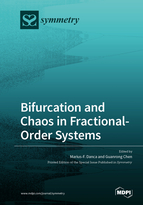Bifurcation and Chaos in Fractional-Order Systems
A special issue of Symmetry (ISSN 2073-8994). This special issue belongs to the section "Mathematics".
Deadline for manuscript submissions: closed (30 November 2020) | Viewed by 20899
Special Issue Editors
Interests: nonlinear dynamics; continuous/non-smooth chaotic dynamical systems of integer/fractional order; fractals
Special Issues, Collections and Topics in MDPI journals
Interests: nonlinear dynamics; complex networks and control systems
Special Issues, Collections and Topics in MDPI journals
Special Issue Information
Dear Colleagues,
The concept of fractional differentiation first emerged in 1965 in a historical correspondence between the Marquise de L'Hospital and mathematician Leibnitz. In the sequel, famous mathematicians such as Euler, Laplace, Abel, Liouville, and Riemann further developed essential technical details. It was realized recently that many scientific phenomena with complex dynamics cannot be well modeled by differential equations using integer-order derivatives. As a result, there has been an increasing interest to merge the mathematical fundamentals of fractional calculus into scientific and engineering applications such as an interdisciplinary approach, which has started to demonstrate some advantages over conventional integer-order systems. Although the previous decade witnessed significant development in this research area, many theoretical and technical problems remain to be further explored, including particularly fractional-order chaotic systems. On the other hand, finding hidden attractors in continuous-time and discrete-time fractional-order chaotic systems represents a new trend of research, one which is equal parts exciting and challenging. Of particular interest are those systems with symmetry, in which bifurcations can lead to a family of conjugate attractors all related by symmetry. Therefore, this research direction of bifurcation and chaos in fractional-order dynamical systems opens up a corpus of opportunities with great promises in such scientific fields as complex dynamics, systems and networks, and signal processing, to name a few. The present Special Issue calls for new contributions to these important and interesting topics of research, and we sincerely hope that you will be happy to participate.
Prof. Dr. Marius-F. Danca
Prof. Dr. Guanrong Chen
Guest Editors
Manuscript Submission Information
Manuscripts should be submitted online at www.mdpi.com by registering and logging in to this website. Once you are registered, click here to go to the submission form. Manuscripts can be submitted until the deadline. All submissions that pass pre-check are peer-reviewed. Accepted papers will be published continuously in the journal (as soon as accepted) and will be listed together on the special issue website. Research articles, review articles as well as short communications are invited. For planned papers, a title and short abstract (about 100 words) can be sent to the Editorial Office for announcement on this website.
Submitted manuscripts should not have been published previously, nor be under consideration for publication elsewhere (except conference proceedings papers). All manuscripts are thoroughly refereed through a single-blind peer-review process. A guide for authors and other relevant information for submission of manuscripts is available on the Instructions for Authors page. Symmetry is an international peer-reviewed open access monthly journal published by MDPI.
Please visit the Instructions for Authors page before submitting a manuscript. The Article Processing Charge (APC) for publication in this open access journal is 2400 CHF (Swiss Francs). Submitted papers should be well formatted and use good English. Authors may use MDPI's English editing service prior to publication or during author revisions.
Keywords
- fractional-order derivative
- fractional chaotic system
- hidden attractor
- symmetry
- complex dynamics






